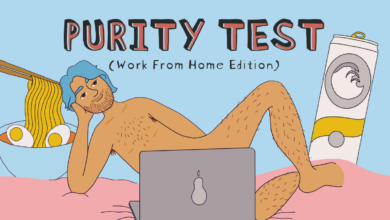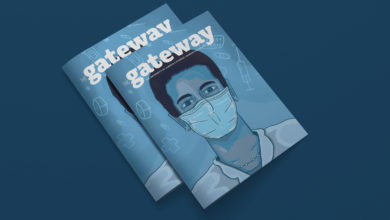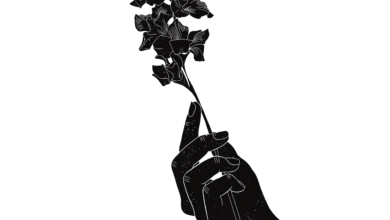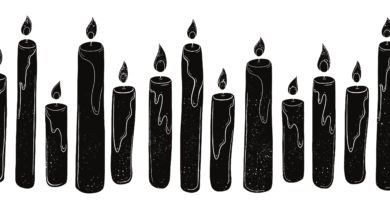Being Heard: Indigenous experience on campus
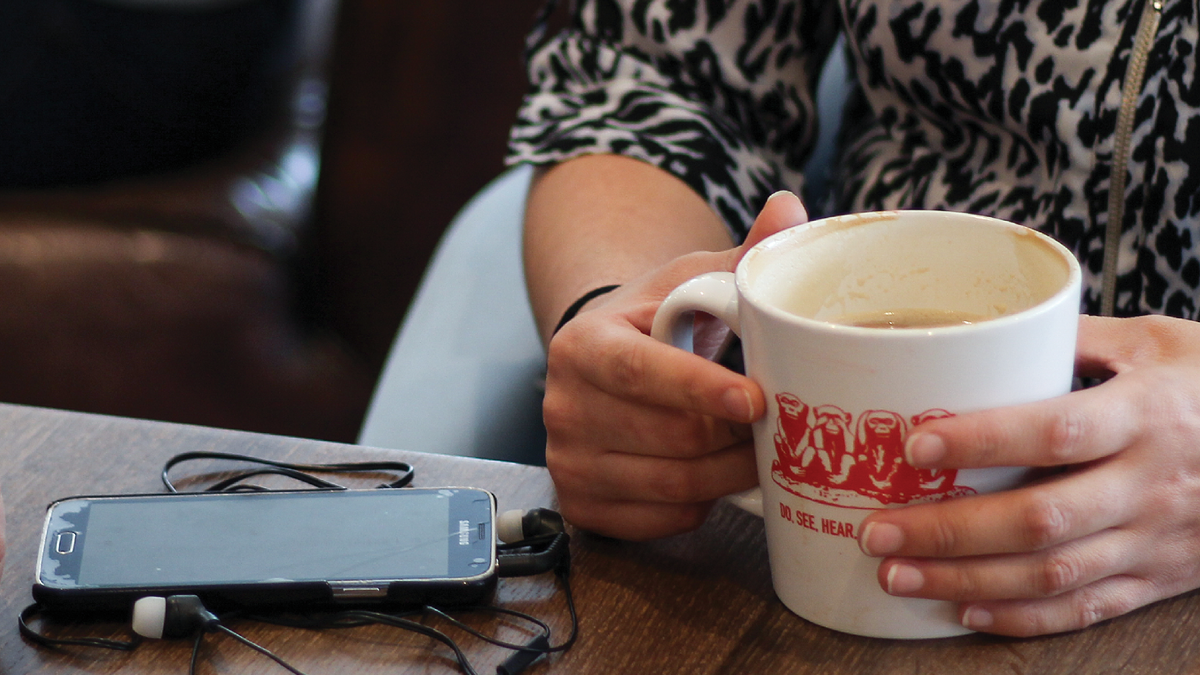 Teresa McKernan
Teresa McKernanHe has a broad frame and tends to rub his hands together when he thinks, elbows braced against the table. He kneads through my questions, carefully mulling over the words. His name is Dylan Cardinal, a former student of the University of Alberta, and a Cree man.

“To everyone else, I’m an Indian,” he says, shrugging.
He digs in his wallet, and pulls out a worn ID card.
“What does that say?” he asks.
I look at his faded picture, and the title above it.
“It says Indian Status,” I answer.
“And what does that say?” he continues.
His index finger points to the department name at the top of the card.
“Indian,” I reply.
“We’re all the same to them,” he says, “You, you are German, and French, and what else?”
“Ukrainian,” I say.
“You’re allowed to have that,” he says, “I’m Indian. Doesn’t matter. I’m Indian.”
Dylan and I stare at each other across the table. Students — white students — bustle around us, studying in the café just off campus. He pulls the brim of his hat lower.
“Thanks, Chris,” he jokes, putting the status card back into his wallet.
“Columbus,” he clarifies, with a wink.

Dylan and I attended J. A. Williams High School in Lac La Biche, Alberta. It was the only high school in town. A sheep farm shares a fence with the parking lot.
“Come on, Megan,” he laughs. “Did our high school prepare us for university? For those class sizes?”
I shake my head, “Of course not. We were so rural. I felt so behind everyone.”
Dylan’s face becomes serious. He continues, “Now think of reservation schools.”
The state of reservation schools has been a contentious issue. In 1971, the Kehiwan band of Cold Lake, Alberta staged protests regarding the inadequacy of reservation schooling, and their living conditions. On October 29th of that year, The Gateway published a special issue entitled casserole — a collection of investigative perspectives on reservation life, and the ongoing protests. One author wrote, “The Indians are fighting to shake off the paternalistic attitude of the Indian Affairs department that has persisted for a century. Indians are fighting for a right to determine for themselves and their children how they want to live.”
The conversations about poverty and inadequate education on reservations is a persistently stagnant one. Reported events have spiralled around an unchanged theme for at least 46 years. Indigenous people want autonomy, a return to their cultural roots, and equitable access to resources on par with the rest of Canadians. Regardless of what the responses have been in each case, it is clear that the deeper causes and impacts have not been resolved.
Dylan, for part of his life, lived in a reservation community called Smallboy Camp. This place had no running water, and only generators for power.

“It’s bushed,” he says.
Dylan tells me about how the community was founded when Chief Robert Smallboy took his people back to the land, away from the addiction, alcohol, and abuse cycling through the families of their reservation. He says that he lacked a lot of comforts when he was there, but it was a good, strong community. It is clear to me that, when he speaks of his time there, it was a challenge, but it holds an honored place in his heart. When we speak of Smallboy Camp, and its limited amenities, his eyes close, fingers steeple, and for a quick moment, I feel like I have lost him to his memories. He keeps many of the intimate moments to himself, but there is a calm that settles in him when he remembers. In those moments, I see him as a young man, disjointed and dispossessed.
At Smallboy Camp, there is one school with four classrooms. They are split by grades K-3, 4-6, 7-9, and 10-12. There are only a handful of students in each room, and the majority of the learning is distance education, without the instructor present in the room to assist the children. Dylan’s father was a teacher at this school. Watching his father with the other Cree children inspired him deeply to take the same path. Dylan wants to be that guiding presence in the lives of both Indigenous and non-Indigenous children. He wants to be a representational presence that can help teach children that there is so much more to being Canadian.
Dylan began his journey at the U of A in the Transition Year Program (TYP), which is an introductory first-year program designed to help ease the transition to university life for Indigenous students. Dylan heaps praise on the TYP, saying that he formed strong friendships in an open and encouraging community. The first version of this program was introduced in 1985, and according to the Aboriginal Student Services Centre (ASSC), it has helped to improve student success and enrollment retention.
The TYP is a way for the university to account for the discrepancies in high school education of Indigenous students, compared to non-Indigenous students, and to give them a fair opportunity to succeed in their academic goals. In the 2016-17 academic year, there were 1,012 undergraduate Indigenous students enrolled at the U of A, 80 of whom were in the TYP. This is the largest population of Indigenous students in the history of the university, and the largest TYP cohort in 14 years. In an annual report, the university claims that this is not just a result of registration, but a “larger number of students who are comfortable self-identifying as First Nations, Metis, (sic) or Inuit.” For the 2016-17 academic year, the U of A hosts a total of 28,683 full time undergraduates, and 2,170 part-time undergraduates, 25,793 of whom are from Canada.
Dylan stopped attending classes to work and save money. He briefly speaks about the difficulty of keeping up with a job and school.
“I pay for your schooling. That’s the worst one. I pay for your schooling,” he says about the comments he often receives with regards to his Indian status. Exasperated, he explains that no, Indigenous students do not just get their school paid for.
“Every reservation and community is given a small grant. And if you’re one of the lucky kids that gets that grant? Awesome. Like me? My community… my community wouldn’t fund me because I didn’t live there in the last 12 months,” he explains.
He continues, “In my first year, I paid my 15 grand.” Dylan further explains to me how there are other programs to help Indigenous students pay for things like tuition and books, but not every Indigenous student is eligible is able to receive that help.
Furthermore, Dylan indicates that he sometimes feels like he must “be a chameleon,” and that he is not forthcoming about his heritage. It is something he keeps private. When I ask him if he feels like he must act differently with white people than with non-white people, Dylan nods emphatically.
“Oh, absolutely,” he says. “But if I know them, and they know me, then I can let that part of me show more.”
He speaks about how white people do not have to change the way they are, when they enter a new space. All space is for them — except for reservations.
“I’ve never felt unsafe there. But white people? They’re shivering. What do they think we’re going to do to them?” he asks.
I ask Dylan if he has immediate plans to return to the U of A. His gaze is a little distant. He shrugs and smiles. He is used to the life of steady income, he jokes. He does not say much to the matter, and changes the subject. Perhaps it is because I have known him for so much of my life, but it seems like there are words he does not want to say out loud piling up between us. I do not to push for more.
Dylan’s experience with university life is not uncommon. Paige L’Hirondelle, a Cree Métis woman, struggles in similar ways. Yet, when she sits beside me, she holds herself with a resilient pride. Throughout our discussion, her voice carries a natural authority, and it shifts between humor and heartache. It becomes clear how hard her determination has become, as she navigates a racialized world.

In her own high school, Paige saw her Indigenous peers disappear, one by one. She says that in the university, it seems as if only a small portion — one-third if she had to guess — of the Indigenous students stay after their first year. Statistical studies have shown that Indigenous students are under-represented in post-secondary enrollment. Specifically, Jane Preston’s review publication “Education for Aboriginal Peoples in Canada” cites Indigenous students as being among those least likely to be among those admitted to Canadian universities. The ASSC states that although the initial enrollment is low, the TYP has raised post-secondary retention rates on Indigenous students to near those of non-Indigenous students. Indigenous enrollment is not an uncommon narrative in political and academic conversations, but Paige thinks there is much more than just funding or infrastructure to be considered.
“I think there are a lot of teachers out there, who don’t realize what they’re saying to students,” she says.
One particular high school teacher treated her differently.
“Because I’m well spoken,” she explains.
To other Indigenous students, “She did end up saying, ‘You’re not going to succeed in what you want to do’. I remember in one of her CALM (Career and Life Management)classes, a student was late, and she was Aboriginal, and she just took her right outside and just started yelling at her. And being a student, you can’t really do anything unless you want to get in trouble, right? But she’s just letting her have it, and saying, ‘You’re not going to succeed, I don’t even know why you’re coming to school if you’re always so fucking late’. Might as well go back to the reserve, kind of thing.”
Paige continues, “Little things like that is probably why students don’t succeed in school. It’s because they’re told you’re not going to be able to succeed in what you want to succeed in. You’re pretty much going to be stuck on the reserve,” she says. “You teach a kid something, likely they’re going to do the exact same thing. Tell someone they’re not going to succeed, most likely they’re not going to succeed, because you didn’t have faith in them, right?”
In The Gateway’s 1971 special issue casserole, Indigenous high school students are quoted to have quit school directly because of racial prejudice. One student states that a teacher tells them, “Don’t act like an Indian.” The student is quoted to say, “You know, that really hurts me sometimes. How is an Indian supposed to act by his thinking, you know?”
Paige is sure that if we want to help Indigenous students succeed: “We have to be building up their confidence.”

As she describes these experiences, we sit in the Aboriginal Student Council office space. There is a teepee in the middle of the round table. A Métis sash lays across from me. Two other students study nearby, and pamphlets for support services or student help are tucked in a folder. Her hands shake slightly, but her voice is steady.
“I want to be a social worker, and in order to fix a problem, you have to know where it started. And it started, it did start, with colonialism, residential schools, things like that … intergenerational trauma,” she trails off. “I don’t like learning about it, but at the same time, I’m going to have to. That’s actually why a lot of Indigenous youth are where they are, in group homes, or just homeless, or all these different terrible things that are going to get them into the jail system.”
“How can we decrease that with each other?” she asks.
Paige expresses outreach ideas for bringing together communities, to help others learn about her own. All she needs is the volunteer power to help her out. One of her goals is to set up tables in Quad, with artwork displayed and food given away, to bring students together to learn. She says that offering food has always been a good way to connect people.
“Let us fill your stomachs, so we can fill your head with knowledge and understanding,” she says, laughing.

Her voice is soft, as she continues, “Look at the love and care that we have for one another, that’s expressed through these paintings, through dance, through story-telling,” she explains, her ring tapping the table as she moves her hands expressively. Connection is one of Paige’s most burning priorities.
“I don’t think the goal is to make you feel bad for what your ancestors did,” she says. “But since you are here now, what can you do to help to make sure those things don’t happen again, or at least to make sure that you’re there to make these people feel welcome or safe, and allow them to feel comfortable with where they are.”
In 1999, The Gateway published Raechel Carpenter’s book review of Stolen Life: The Journey of a Cree Woman by Ruby Wiebe and Yvonne Johnson. Carpenter details the ugliness of the violence, addiction, suicide, and suspicious deaths that happened in Johnson’s life. Carpenter writes about how shocked she is that an individual can survive what Johnson has been through. These experiences are still a common happening within Indigenous communities. Katherine Belcourt, a Cree woman, speaks at length with me about the prevalence of these effects of the intergenerational trauma on students in university today. Katherine is the first in her family to go to university, and to have finished high school on time.

She says, “Having been the only one going to university, I feel more like I don’t have a lot of guidance. My grandma went to residential school, and that took a lot away from my family. Especially the support needed to develop healthy relationships and coping mechanisms. Trauma puts people in survival mode. Anger, addictions, and walking away from problems are some of the unhealthy coping methods that some members of my family use. So, I’ve really had to learn how to live a healthy life for me and my daughter. It’s really hard sometimes.”
Katherine has a perspective of healing, one of needing adequate programs in place to help the Indigenous students who need to untangle that layered, intergenerational trauma. There is a steady pace of positive resolve to help her community.
She continues, “You come in, and you’re trying to learn how to be a student, and learn how to study, and learn how to cope with all of these things, but there is this new level of stress. You are already dealing with all these different stressors, and the problem is not having the tools to deal with family stress, let alone school stress, and let alone having all of these different layers of trauma. And it surfaces, and it’s hard to deal with everything at once. I think that’s really overwhelming.”
Katherine began her journey in the Faculty of Engineering, and through the stress of a new learning regime, the stress of not having familial or faculty support, and at the onset of personal trauma in her life, she withdrew from the program. Katherine took a year off, and re-enrolled in the Faculty of Science with a major in biology, and a minor in psychology, with the goal of attending medical school. Amidst the emotional wilderness that Katherine has navigated, she never loses hope.

She sits on the Aboriginal Relations and Reconciliation Committee (ARRC) — an ad hoc committee that includes two members of the Students’ Union (SU). Katherine notes that the ARRC gives Indigenous students a firm presence in reconciliation. For Katherine, this initiative allows Indigenous students the opportunity to work together with student government to resolve challenges specific to Indigenous students, and ensures accountability in the presentation and execution of solutions. With the ARRC, Katherine has found a place to help create solutions with meaningful actions that are sensitive to the individual histories of Indigenous students, and the impact of those histories. To Katherine, it only makes sense to have Indigenous people intimately involved in reconciliation efforts, and she remains ever optimistic about the future of these efforts.
It is important to note at this point that the experiences of Indigenous people are mainly experienced by the non-Indigenous public through the lens of media like these newspaper reports. Furthermore, here I am, another white person in a long lineage of writers reporting on Indigenous experiences — what seems like the same experiences — as my predecessors, almost half a century ago. Through the 2000s, the Gateway has published on violence towards Indigenous women, the need for respect and understanding in the reconciliation process, and how Indigenous students are less likely to graduate.
Although many challenges remain for Indigenous students, there is a forward momentum within their community on campus. The work and progress made here is significant, and is another step forward on our long journey to reconciliation and healing. To Katherine, the key to progress is in shared solutions, founded on equal footing.

She says, “We find solace in our communities, because when Indigenous students come together we do not have to explain ourselves. We all understand trauma, intergenerational trauma, and living with the effects of residential school. We relate through academic struggles, managing university with subpar educational backgrounds. Knowing that our coping skills are impacted by the mental health issues within ourselves and our families, we understand the realities of addictions, the toll of suicide, homicide, and premature death. We know how trauma impacts our success, but we come together and support each other. We are resilient, and though we should not have to put in several times the effort of our counterparts, we continue to overcome these barriers. Indigenous students are not victims nor radical people, we just want people to acknowledge the challenges we face, to understand why we face them, and work with us to overcome these barriers. Also, that we are not all the same, so this may look different for everyone. But we are kind, capable people.”

